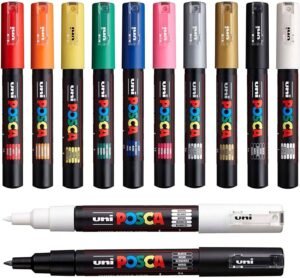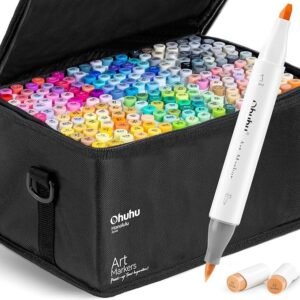Step-by-Step Guide for Using Markers and Pencils
- Prepare Your Surface: Ensure your paper or canvas is clean and smooth. For markers, use marker paper to prevent bleeding. For pencils, any quality drawing paper will work.
- Select Your Tools: Choose the appropriate Arrtx markers or pencils for your project. Consider using water-based markers for blending and alcohol-based markers for vibrant colors.
- Sketch Lightly: Start with a light sketch using a graphite pencil to outline your design. This allows for easy erasing and adjustments.
- Apply Base Colors: Use markers to apply the base colors. Apply light, even pressure with pencils to avoid breaking the tip.
- Build Layers: Gradually build up the color intensity with markers by layering multiple coats. With pencils, layer colors lightly to create depth and texture.
- Blend Colors: Use blending techniques to create smooth transitions between colors. For markers, use a blending marker. For pencils, use a blending stump or burnishing tool.
- Add Details: Use fine tips for detailed work and highlights. Markers with fine nibs or pencils with sharp points work best.
- Finalize: Ensure the artwork is complete and make any necessary touch-ups. Review your work for any inconsistencies and correct them.
Types of Markers and Pencils
- Markers:
- Alcohol-Based Markers: Vibrant colors, suitable for layering and blending.
- Water-Based Markers: Easier to blend, less likely to bleed through paper.
- Brush Markers: Versatile tips that can create both thin and thick lines.
- Pencils:
- Colored Pencils: Wide range of colors, suitable for detailed work.
- Watercolor Pencils: Can be used dry or with water for a watercolor effect.
- Graphite Pencils: Various hardness levels for sketching and shading.
Guide for Proper Use and Care
- Storage: Keep markers and pencils in a cool, dry place, away from direct sunlight. Store markers horizontally to prevent the ink from pooling.
- Cap Markers: Always cap markers tightly after use to prevent drying. For double-ended markers, ensure both caps are secure.
- Sharpen Pencils: Use a high-quality sharpener to maintain pencil points. Avoid excessive force to prevent breaking the core.
How to Repair Markers or Colored Pencils
- Markers: If dry, try adding a few drops of isopropyl alcohol to the nib. Allow it to soak for a few minutes before testing. If the nib is damaged, consider replacing it if possible.
- Pencils: For broken cores, use a pencil extender to make use of the remaining pencil. If the pencil is split, gently glue it back together and allow it to dry fully.
How to Use Markers Correctly on Non-Professional Paper
- Paper Selection: Choose a heavier weight paper to minimize bleeding. Avoid thin or recycled paper.
- Test First: Test the markers on a small area to see how they interact with the paper.
- Light Pressure: Use light pressure to apply the ink to avoid oversaturation and bleeding.
- Layering: Allow each layer to dry before applying the next to prevent smudging.
How to Make a Homemade Marker
- Materials Needed: Felt, plastic casing, ink (dye or pigment-based), and a secure cap.
- Assembly: Cut the felt to fit inside the plastic casing, ensuring it reaches the ink reservoir. Fill the casing with ink and insert the felt. Cap tightly to prevent drying.
How to Use This Brand Correctly
- Read Instructions: Follow any guidelines provided by Arrtx for optimal use.
- Experiment: Test different techniques to find what works best for you.
- Practice: Consistent practice will improve your skills and familiarity with the products.
Solving Problems When Markers Dry Out
- Reviving: Add a few drops of isopropyl alcohol to the nib to rehydrate.
- Storage: Store markers horizontally to keep the ink evenly distributed.
How to Disassemble a Marker
- Remove the Cap: Carefully remove the cap without damaging the nib.
- Disassemble the Barrel: Gently twist or pull apart the barrel to access the ink reservoir.
- Remove the Nib: If replaceable, carefully pull out the nib. If not, clean it as much as possible.
- Reassemble: After cleaning or replacing parts, reassemble the marker by reversing the steps.
How to Store Your Markers
- Horizontal Storage: Store markers horizontally to ensure even ink distribution.
- Cool, Dry Place: Keep them in a cool, dry place away from direct sunlight.
- Organized: Use storage boxes or cases to keep markers organized and protected.












